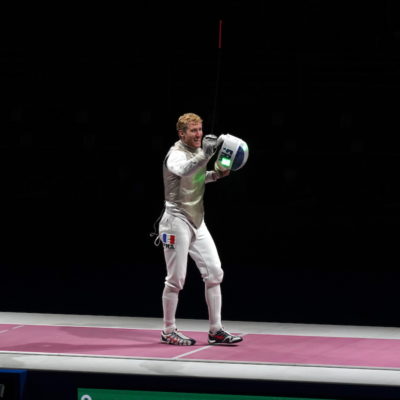Beijing’s Games III: The Psychology of the Team Game
The team event is the wild card in fencing. By history of the sport and temperament of the athletes, fencing is an individual sport. But the team event has taken on increasing importance in recent years. Team competition is critical to the success of the national teams. It is the only realistic way to put 3 fencers in the Olympic Games, and create 4 chances to win a medal.
{sidebar id=1}But the team competition remains much an afterthought, like a second chance that comes after the individual event — that is, when there is an opportunity to compete at all. Despite its conspicuous importance to the success of the US Fencing, there is virtually no systematic grass roots preparation, and typically only a single meaningful yearly opportunity to compete – at Summer Nationals.
The introduction to the team game in earnest typically does not come until athletes are internationally competitive. And, there is relatively little time and energy devoted to specific tactical and psychological preparation for the event. In some quarters, the approach to team competition borders, by analogy, on teaching someone to swim by pushing them into the deep end. Clearly, much remains to be learned. Turning a careful eye to the team competitions in the Beijing Games promises to be revealing. A primer on the what, why and how of the team event follows.
Preparation for the team competition begins as one day’s competitors become the next day’s teammates. With the change to the relay format (from the multiple individual bout format), the psychological dimension is expanded and the tactical complexity is greatly enhanced. Now that the fencers are together for the entire competition there is a more vibrant interpersonal dynamic with the teammates in it together every step, every touch of the way. This opens the door to a much broader range of opportunities for true team play – and demands a rethinking of roles. Attention to team psychology for cultivating cohesion, support and leadership takes on particular importance, adding another layer to the skill set that defines the successful coach.
The power of a true team is often conveyed in the well worn maxim, that the whole is more than the sum of the parts. As tired as this phrase may be, it proves itself over and over again. There is probably no better example of this than the recent struggles of USA Basketball to win international competitions. In contrast, the cold war era win by US Ice Hockey over the far superior Soviet Team, stands out as one of the greatest Olympic victories of all time.
Just as compelling as the psychological dynamics is the expanded scope of team tactics – including everything that is relevant to the individual event and then some. There are tactical roles that run completely counter to the individual game. For instance, in a team match a 0 – 0 bout can be an important tactical victory. In foil and epee this gives rise to the role of the “Stopper,” a fencer who is good at keeping the score low, and who can frustrate a superior individual fencer. Given the swings in scoring that can come especially in later bouts, the role of the stopper is important in neutralizing the ability of the star fencer to go on a big run.
New tactics translate into new roles, which in turn, carry their own distinct psychological demands. Consider the role of the “Closer,” the one who fences the last of the 9 bouts and on whose watch comes victory or defeat. Is the best fencer the best closer? Not necessarily. From a psychological perspective, the closers are those for whom accountability to teammates is a boost that lifts them, as opposed to a burden that weighs them down. Of course, there are physical and tactical demands to the position. The closer needs to be someone who is strong and well enough conditioned to fence hard for the full three minutes (plus a minute of overtime, if necessary). He or she must be able to vary their game to match the opponent’s weaknesses, and to make timely tactical adjustments if the first plan does not work. There must not be any obvious technical weaknesses that the opponent can exploit. The role of the closer is conveyed in the maxim of team competition: “The role of the team is to put the closer in a position to win.” By way of analogy then, the closer is like a goalie, the one who guards the gate to victory, the last one to beat. Perhaps soccer and ice hockey have something to share with fencing in this regard.
It is not long before any conversation about the team game arrives at the realization that there are individuals who simply do not perform as well in the team event as they do individually – and the reverse, that there are some fencers who appear to perform above their ability in team competitions. Is the better team fencer one who is able to cultivate a kind of give and take with others that creates cohesion and makes the group stronger and more resilient? Or could it be the fencer who is flexible enough mentally to adjust to the varying tactical situation that arise in the team competition – starting ahead or behind; dealing with the (sometimes huge) momentum swings that are prone to occur. Most of these questions remain to be answered. But perhaps the most difficult question is how to choose the best team. One might ask, “Do the top 3 or 4 fencers on the points list make the best team?” But this is a question for another time.






1 Comment
Comments are closed.